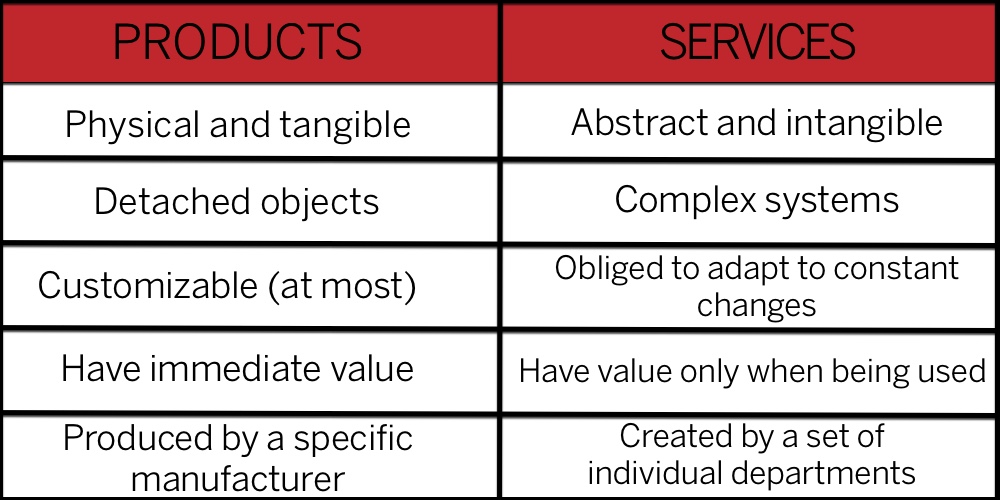What makes one product better than a similar competitor? Why do people talk about competitiveness in the market? What prompts technological evolution?
Let’s look back at the first Bell’s phone: isn’t it the ability to talk across distances that mattered? Today’s “phones” offer that same feature, but what we value about them is not oral communication capability, but the entire set of experiences they offer, from taking instant photos and sharing them with friends, to shuffling playlists that fit a user’s current mood, to tracking daily habits.
The moment a tangible product starts being a point of interaction with life, it turns into a service experience that matters. Indeed, it’s not the physical devices we really cherish, but rather the experiences they bring. Technology, devices, and applications are nothing but tools that allow us to make emotional connections.
So, to design experiences that make sense in the context bounded to people’s everyday lives, it’s important to shift away from designing the value of things and instead design valuable experiences. And this is where service design emerges.
Fundamental Concepts
If we ask ten people what service design is, there would be eleven different answers—at least.
Service design is not a new discipline, but rather a new way of thinking aimed at providing a holistic service experience to the customer. It can be viewed as a broader, interdisciplinary version of user experience design. Where UX design focuses on the experience of human-computer interactions (HCI) with a digital product, service design is created using different methods and tools of various disciplines, covering the entire service experience.
What’s the difference? For a clearer understanding, let’s compare service features with the specifics of a product:
Given the comparison above, where would a desired website or a mobile app fit better? There may not be a clear answer, but in the majority of cases it will probably go into the services category.
The Key to Service
Uber is known for providing an excellent customer experience, due to their ability to offer a quality service with few features and a high success rate of meeting and exceeding customer expectations. The experiences they deliver can be broken down into five pieces, originally identified by service design enthusiast Marc Stickdorn in his book, This is Service Design Thinking: Basics, Tools, Cases. Stickdorn believes that service design comes down to these five aspects:
- User-centered: Service is a result of collaboration between a service provider and a customer. It should speak in a customer’s language and reflect the customer’s needs.
- Co-creative: Service design is about designing with people, not just for them. There are various stakeholders involved in creating, providing and consuming the service. The process of designing services should include all of them.
- Sequencing: Every service has its own pace. Sometimes it can be too slow, resulting in bored customers, and sometimes it is too fast, stressing them out. Service should always keep up with customers’ expectations.
- Evidencing: In order to be noticed, intangible services should be accompanied with physical evidence: mail, brochures, souvenirs, etc… They can trigger the memory of positive service moments far into the post-service period.
- Holistic: Environments where service takes place, engaging customer journeys and their alternative forms, the corporate culture and staffing of service providers—all these aspects, together, create the service mindset.
Let’s look at how Uber’s service corresponds to these five principles. The mobile application provides an amazingly simple car hailing experience, which is inherently user-centric—it focuses on the user’s need for a ride, and gives them a simple solution: tapping the Uber app. The interaction could end here, succeeding in its job of connecting a rider with a driver, but the service isn’t over until the payment is made and the user has waited for their car, been driven to their destination, and received their receipt. Thus, Uber pays attention to each step: providing the user with a real-time map to watch for the approaching car, and following up with an emailed receipt, titled with a friendly, “Your Friday evening trip with Uber,” all of which demonstrates a holistic approach to a continuous experience.
Still, there’s always room for improvement. So, after your ride, you can leave feedback. Uber representatives will send you a follow up, so you know your opinion matters, displaying co-creativity that makes the experience even more personal.
Why Now?
In order to be viable, any innovation needs a number of factors to function. There are three key reasons to shift to service design thinking today:
- The age of information is reshaping the way people live. Yet, the quality of offerings often suffers due to the complexity of combining diverse data in a way that makes sense to people. It’s often difficult for an average user to understand most of the services out there in the world. This is one of the reasons for service design to exist: to reduce the distance between the service and its customers.
- As a cornerstone of the industrial era, “Featurism” is almost over. Today, it’s not the features themselves that matter, but rather the way in which they are put together and brought to the customer. It’s better to have one useful feature that really works than a multitude of them just for the number’s sake.
- Customers are demanding more. Listening to and meeting customer expectations is the key to customer satisfaction, but to achieve real business success, more value should be delivered than what’s expected. Service design is the way to achieve it.
Takeaways
Imagine you’re making pizza and selling it online. Let’s say you already have a beautiful, engaging, and usable website. You even have a mobile app that provides the ability to place an order on the go. Good job! But how can that be improved even more?
It’s not the physical devices we really cherish, but rather the experiences they bring
Think about your creation with those five key principles in mind. Let’s say you have a pizza spot right next to the MIT student campus. Of course, they are your permanent customers because you are within easy reach—and what’s better than a hot cheesy pizza? The answer is: a themed pizza that perfectly fits MIT geeks’ interests: For example, on the verge of a new movie release you may add a bit of themed flair to your service: incorporate your website with special effects, come up with special movie or comic inspired offers, etc. (Of course, make sure that you’re not violating any copyrights!).
Then, redesign the package and add a stylish pizza cutter inside. Entice your customers with the possibility of winning tickets for the premiere with a hidden coupon inside. Let the delivery guy wear a costume. Make your customer be hungry not only for pizza, but the way you deliver it. Think out of the pizza-box, and your customer’s mouth will water because of your service.
The point is, find ways you can breathe life into a digital product, make it a continuous experience, and stay connected with customers. If treated as a service, a product will inevitably become one.
Image of bike courier courtest Shutterstock.








